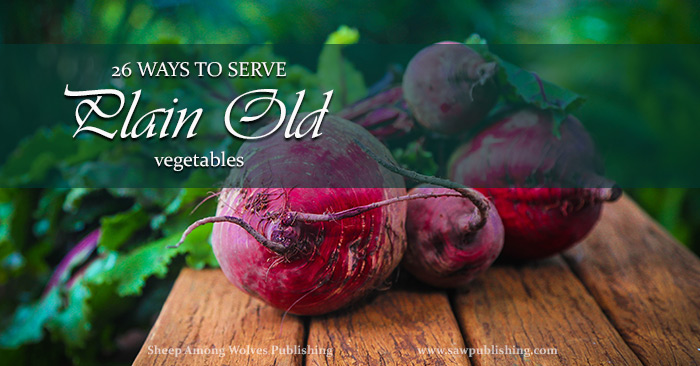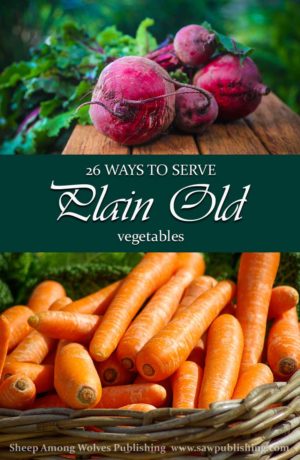26 Ways to Serve Plain Old Vegetables
Timeless Tips from Homemakers of the Past is an ongoing series highlighting useful and thought provoking tidbits from the generations of homemakers who have gone before us. Our goal at Sheep Among Wolves is to provide a forum for Good and Great literature, and to help you in your quest for godly, high-quality resources. It is our hope that these Timeless Tips will be an aid and encouragement to you as you strive to follow the example of Titus 2, and become a keeper of the home.

If you’re anything like I am, cooking dinner can become rather boring. Especially the vegetables. It’s bad enough in my opinion to spend a whole afternoon cooking a meal that gets eaten in half-an-hour—but it’s far worse, if nobody even likes what their eating!
And when the meat dish is accompanied by boiled carrots, or boiled broccoli, or boiled peas or—well, boiled anything—what else can you expect?
But cooking vegetables doesn’t have to be that way. It can be more fun in the cooking, and more fun in the eating, and the answer is just a little more variety.
14 Vegetables – 26 Ways To Serve Plain Old Vegetables
 Variety in your vegetable dishes doesn’t need to come at the cost of fancy or time-consuming meals.
Variety in your vegetable dishes doesn’t need to come at the cost of fancy or time-consuming meals.
A Manual of Home-Making, by Martha Van Rensselaer et. al. (1919) creates enough vegetable dishes keep you supplied for almost an entire month—yet never goes beyond four basic cooking processes to make them.
The secret lies in using a broad enough spectrum of vegetables—and a broad enough spectrum of cooking processes. But lest the reader conclude that we’re counting steamed vegetables and boiled vegetables as separate dishes, let me clarify. A Manual of Home-Making provides not just 26 ways to cook, but 26 different ways to serve plain vegetables.
But I’ve Never Cooked Asparagus Before!
Quite probably, many of you are new either to some of the vegetables, or to some of the ways of cooking them. However, apart from a few vegetables such as asparagus which may be expensive or seasonal, most of them are available year-round at moderate prices.
Included in A Manual of Home-Making are a series of pointers on:
- How to choose each vegetable at the market.
- How to prepare each vegetable for cooking.
- How to cook each vegetable (usually including cooking times).
- How to garnish and serve each vegetable once it’s done.
Step-by-step advice like this makes it easy to try new vegetables, and new ways of cooking familiar vegetables.
The Four Basic Processes
One of the best parts of these recipes is the fact that they all use only four simple cooking processes. Probably most of you will already be familiar with these, but in case they need some clarifying:
1) BOILING is a method of cooking foods by submerging them either partially or entirely in boiling water. Sometimes vegetables are placed in cold water, which is then brought to the boiling point; in other cases, already boiling water is poured into the pot containing the vegetables, and the pot is then returned to the stove, and brought back to the boiling point again. Cooking times are usually measured from the time the water boils, not the time the pot is placed on the stove. Salt is sometimes added to water for boiling, as it allows the water to maintain a higher temperature without evaporating.
2) SIMMERING is closely related to boiling, except that the liquid is only heated to a temperature just below the boiling point. Simmering is a gentler process than boiling. It can be safely carried out with only a small amount of liquid. Tomatoes, for instance, may be simmered in their own juice, without adding any water.
3) STEAMING is the process of cooking foods above boiling water. Some type of perforated container, designed for the purpose, must be used to hold the food above the water. Food cooked by steam is more nutritious than boiled food, since fewer nutrients are lost in the water.
4) BAKING is cooking by dry heat—for practical purposes, cooking in an oven. Like steaming, it prevents the loss of nutrients into water. It can also be an economical way of cooking vegetables, since one oven can be used to cook several foods at the same time. On the other hand, only certain vegetables lend themselves to baking.
From the material provided by A Manual of Home-Making, we have compiled a PDF explaining which process to use when—and how to serve the vegetables once they’re cooked.
26 Ways to Serve Plain Old Vegetables
So, maybe it’s my own fault that cooking dinner is boring—now that I have the knowledge and resources to make it better.
Cooking new vegetables—in new ways—is easier than it looks. Thankfully, we aren’t the first generation who has experiment with cooking vegetables. We have access to many decades of cook-books and other culinary resources.
And if you want to make cooking vegetables easier and better, without spending hours researching and experimenting on your own, all you need to do is download our complimentary PDF and start cooking!
Would you like to be more organized, but don’t know where to start? Check out A Manuel of Home-Making’s Timeless Tip on organization:
You might also enjoy:





